
FRIDAY, DEC 30, 2022: NOTE TO FILE

The Cult of Civilization
You could be a member of the cult of civilization if…
Eric Lee, A-SOCIATED PRESS
Abstract: The title is from Tom Murphy’s Do the Math blog with the rest in mostly different words. The idea rings true and therefore should be considered/repeated/spread, imitation being the sincerest form of flattery.
COOS BAY (A-P) — There are more ex-cult members than cults, so having heard some of their stories and knowing a cult when you see one (except the one you are in) is assumed.
The conjecture is that we products of Modern Techno-Industrial (MTI) society, the now global monetary culture, aka World Socioeconomic-political System (WSS) are true believers. We believe, in all deepity, in what to anyone outside the MTI/WSS form of civilization looks like the starkest madness, e.g. that humans are exceptional; that human life is sacred; that we are destined to fill the Universe with wonder; that we are part of some master plan; that we clever apes will come to live forever and to innovate ourselves into a technological singularity; that we will go fourth to expand into space at faster than light speed unto Growth everlasting, i.e. that Malthus was wrong.
And Malthus was wrong, dead wrong. He envisioned growth as being only for a time, destined to transition to a steady-state, and failed to foresee the possibility of climax being followed by descent, by a Great Selection, a possible race to the bottom that terminates at zero. If there is no descent in humanity’s future, then we are not in overshoot of any sort (e.g. ecological, complexity, density, psychological, cognitive, financial, civilizational).
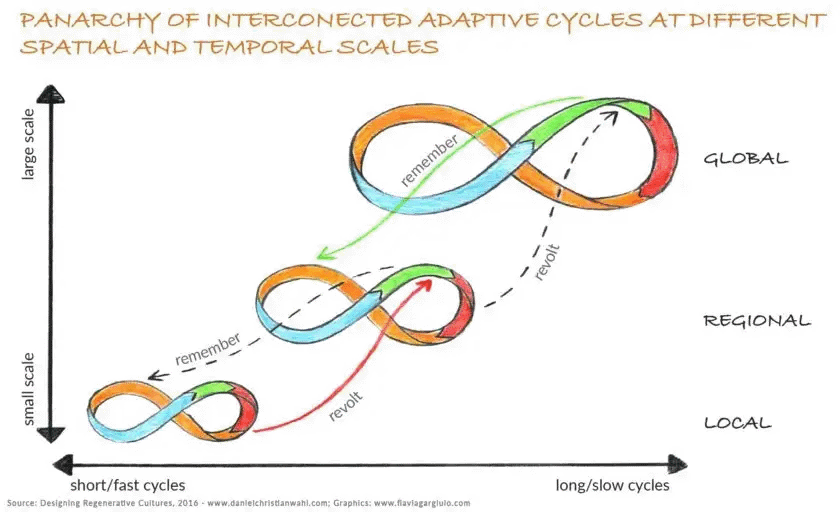
Panarchy of Adaptive Cycles, adapted and expanded from Gunderson & Holling (2001)
A Perhaps Better View:
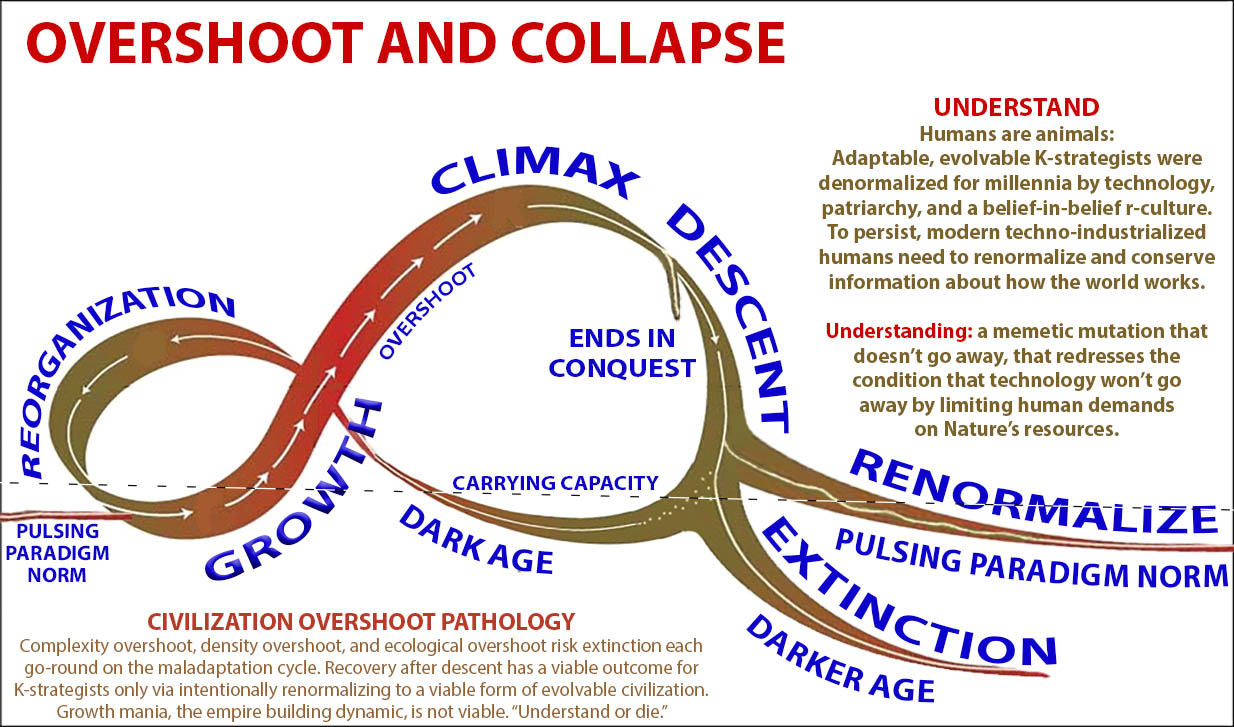
I count 11 dark ages and 42 darker ages, total 53, but I like the number 42, stopped counting, and adding to the list is an exercise I’ll leave for the student. So as I’m math challenged, let’s go with 44 darker ages, for a total of 55 dark/darker ages. So, when complex societies decline (e.g. all prior ones), those that are not conquered early on as they weaken (there being no outlying upstart empire builders to conquer them), then in even numbers, figure a 20% chance that collapse of overcomplex society won’t be so bad (e.g. fall of Western Roman Empire), such that recovery is possible (happens on average after 290 years on the downslope before recovery), meaning the expansionist society reboots to repeat the pattern of overshoot and collapse.
Oh, but this implies an 80% chance that what, in all hopium, looks like just another dark age, another spin on the adaptive cycle, lasting 50 (maybe 70) years (certainly not 290 years), will actually be a darker age. Overcomplex societies collapse: And then what? There's a downslope. Assume 8 to 20 generations on the downslope (just because our collapse may not be exceptional).
The dynamic of life on the downslope could select for dissolution, could be a dissipative event without recovery. After generations of doing what works to persist on the downslope (e.g. Land and Sea Peoples of the Late Bronze Age collapse), those whose great, great, great, great grandfather was born on the downslope (whose ancestors for 8 to 12 generation had been denormalized on the upslope) may continue to do what seems normal even after their remnant population is well under the carrying capacity of the environmental productivity of their habitat. Conflict between takers may seem normal, necessary, compelling and transitioning to a viable form of civilization may be of profound disinterest (not possible), as happened on Malta and in the Indus Valley region.
So, do the math. Playing the Adaptive Cycle Game may have a winner (20% of the go arounds), but long term is a loser's game. The only winners are those who don't play the game, e.g. all K-strategists over the last 500 million years. Your hominin ancestors for over six million years didn't play the game (okay, a few likely did, but they self-selected out of the Game of Life).
The remnant populations of San, Hadza, and Pygmy in Africa are the only normal humans left (with the possible exception of the renormalized Kogi) that don't play the Adaptive Cycle Game because they know (their ancestors learned the hard way) that playing the Adaptive Cycle Game is maladaptive (the Let's Build an Empire Again Game and Grow, Baby, Grow Game), is not viable (always incurs harm).
So, you want to be an adaptive K-strategist (and maybe persist as a species by renormalizing)? First, don't play the Empire After Empire After Empire Game as not playing is the only way to (maybe) win. Play the Adaptive K-strategist Game, instead.
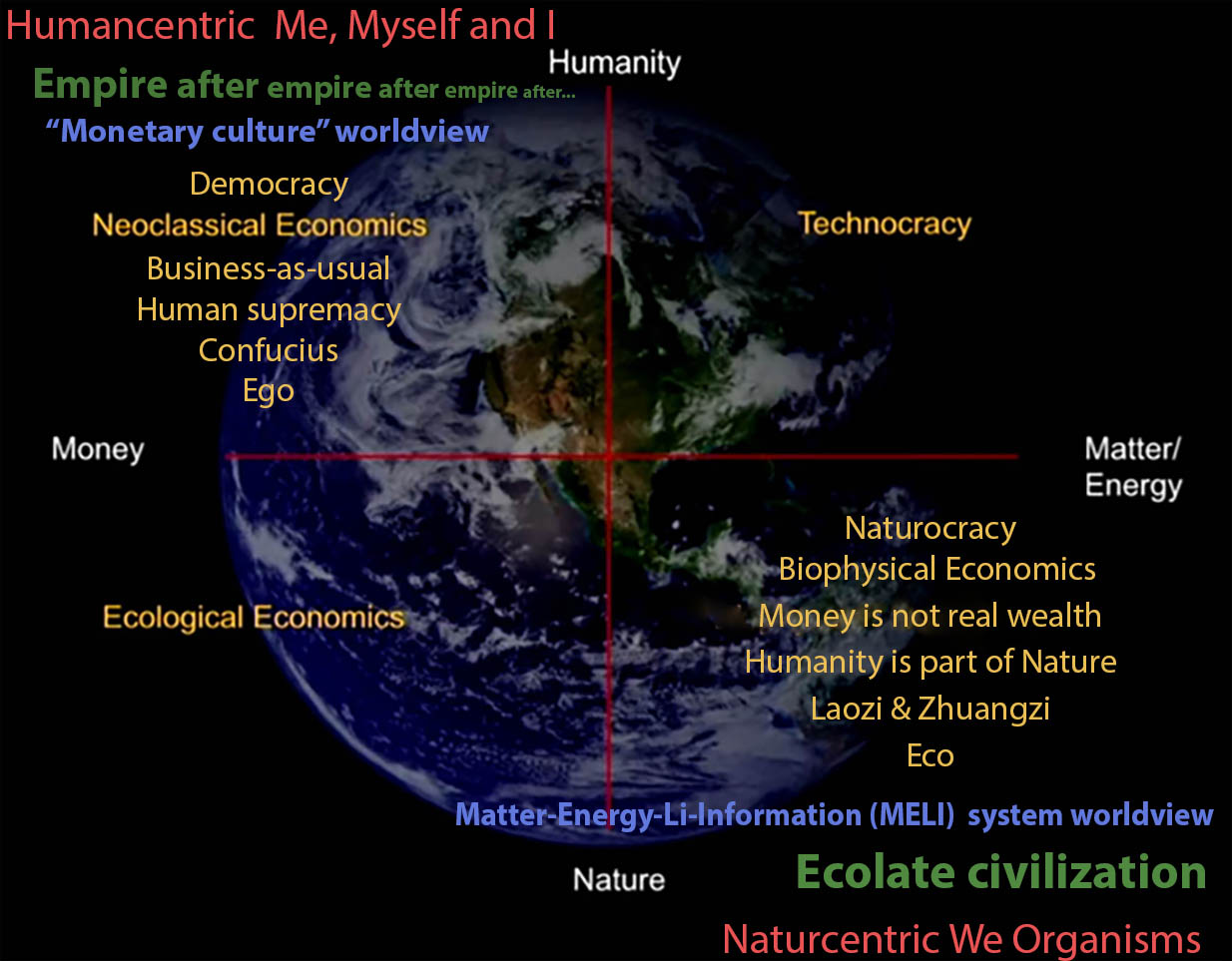
Adapted from Mark Brown, Beyond Growth: Economics as if the Planet Mattered, 2/5/2019.
"Monetary culture" vs matter-energy system worldview. —M. King Hubbert
'Li' is Chinese for the laws—organizing principles—of the cosmos.
Technocracy and ecological economics were/are transitional.
Naturocracy: Technocracy for the 21st century.
Note: our humancentrism renders us incompatible with persisting as a lifeform on this planet.
So all you wannabe Borg, start by moving to Mars to serve Elon Musk in his retirement
where as a transhuman he will live for centuries and as a brain in a vat,
he'll serve hu-manity as the millennia go by.

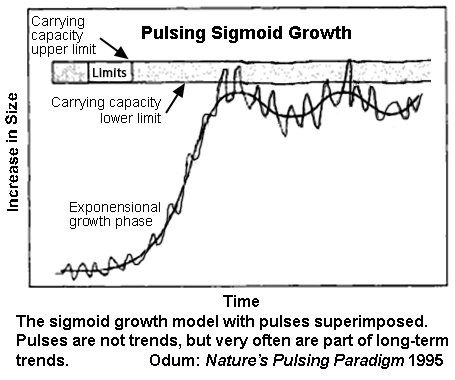 Ask your ancestors going back about 500 million years how. To play, you have to learn the rules of the game (e.g. thou shalt not overshoot the upper carrying capacity limit of thy biome). You have to listen to Nature (Gaia, Aluna, your preferred metaphor) who has all the answers.
Ask your ancestors going back about 500 million years how. To play, you have to learn the rules of the game (e.g. thou shalt not overshoot the upper carrying capacity limit of thy biome). You have to listen to Nature (Gaia, Aluna, your preferred metaphor) who has all the answers.
Primates may prattle (especially the usually clothed ones), but assume they don't know, and never determine, what works to persist. If a human who endeavors to listen to Nature prattles on about what works, know that at best they are repeating what they think Nature is telling us.
Most of us MTIed ones are products of 8 to 12 generations on the upslope that has denormalized each generation like rats and mice in a Calhounian enclosure (aka modern techno-industrial civilization). If our descendants spend 8 to 12 generations on the downslope, they may not renormalize but denormalize further (but in different ways, e.g. thinking that other humans taste like chicken) with a death squared outcome.
At risk of yelling and swinging rhetorical 2x4s against blindered heads (products of the modern techno-industrial (MTI) schooling system), we products of the MTI form of civilization are not normal humans. We are all (except for San, Hadza, and Pygmy) desendents of a small population of Homo sapiens sapiens in East Africa 50k to 60k years ago who rapidly expanded as an invasive species within and out of Africa with megafauna extinctions on six continents (including Zealandia), including all non-expansionist forms of hominins including other Homo sapiens in and out of Africa (exept San, Hadza, and Pygmy yet).
The climax of our succession, 50k years in the spreading, is likely this century when Gaia will inform us (those who would listen) that we exansionist form of human can renormalize (successfully as trying doesn't count) as adaptive and evolvable K-strategists or die. Expect that few or too few humans will realize the difficulty of avoiding a ghastly future, and that underestimating the challenge will be fatal.

You Could Be a Member of the Cult of Civilization if You Agree That:
- Humans are the paragon of about 8.7 million species of animals on Earth.
- We are the axis about which the Cosmos of ~2 trillion galaxies within the observable Universe spins (not so sure about the unobservable Universe).
- All human life is to value, to extend with medical intervention, and we cannot rest until all diseases have a cure, including that of aging.
- Empires may rise and fall in adaptive cycles, but each go-around leads to greater achievement, to greater perfection unto panarchy.
- More is good, better, best, so never never let it rest as the good has to be made better, and the better has to become best.
- Human life must be lived in freedom and dignity, in full realization of our human rights, without limits upon our pursuit of perfection.
- We must all believe in the greatest good for the greatest number, in Growth everlasting.
- All true humans view nature is an externality, that to live in a state of nature like animals, subject to nature’s laws, is a condition not worth living in.
- By endless technological progress we have come to lord over planet Earth, the first of billions for the taking to come to we who would take them.
- We pieces of work must believe in and serve the commonwealth of the Borg Collective and the supremacy of all individuals who serve it.
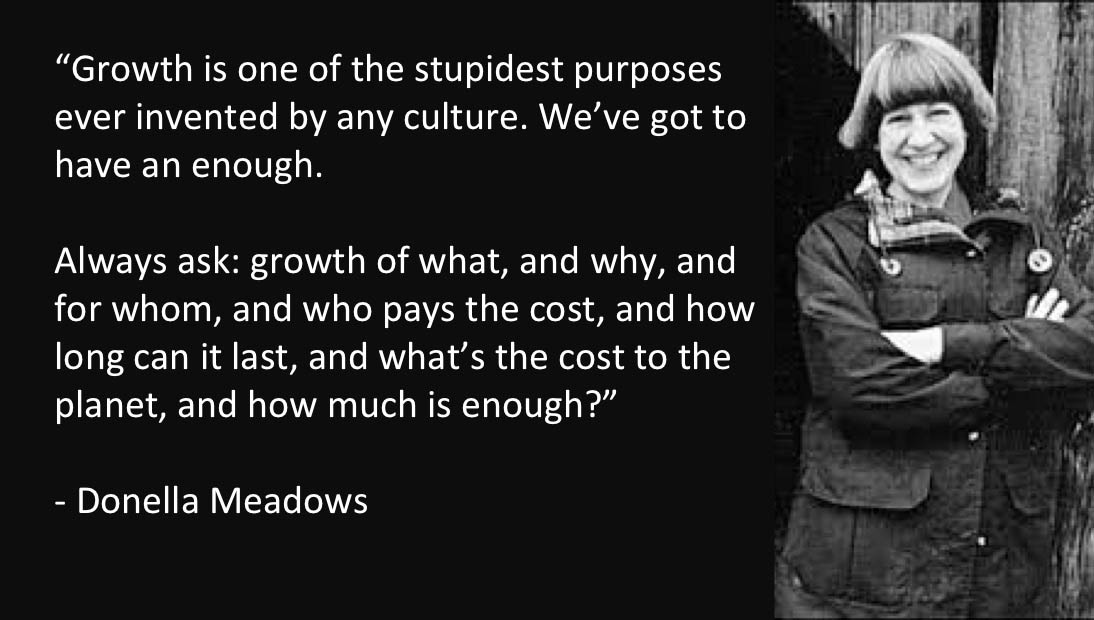
No truly civilized Anthropocene enthusiast would ask such questions.
Originally published at Medium
SUBNOTE TO FILE 12/30/2022
Tom Murphy of the Do the Math blog mentioned in the abstract above has a book out that all young humans should read to better understand the future they will live (or not) in. I have not read it yet, but the book's abstract could be the most important abstract written this decade:
Energy and Human Ambitions on a Finite Planet
Abstract:
Where is humanity going? How realistic is a future of fusion and space colonies? What constraints are imposed by physics, by resource availability, and by human psychology? Are default expectations grounded in reality?
This textbook, written for a general-education audience, aims to address these questions without either the hype or the indifference typical of many books. The message throughout is that humanity faces a broad sweep of foundational problems as we inevitably transition away from fossil fuels and confront planetary limits in a host of unprecedented ways—a shift whose scale and probable rapidity offers little historical guidance.
Salvaging a decent future requires keen awareness, quantitative assessment, deliberate preventive action, and—above all—recognition that prevailing assumptions about human identity and destiny have been cruelly misshapen by the profoundly unsustainable trajectory of the last 150 years. The goal is to shake off unfounded and unexamined expectations, while elucidating the relevant physics and encouraging greater facility in quantitative reasoning.
After addressing limits to growth, population dynamics, uncooperative space environments, and the current fossil underpinnings of modern civilization, various sources of alternative energy are considered in detail— assessing how they stack up against each other, and which show the greatest potential. Following this is an exploration of systemic human impediments to effective and timely responses, capped by guidelines for individual adaptations resulting in reduced energy and material demands on the planet’s groaning capacity. Appendices provide refreshers on math and chemistry, as well as supplementary material of potential interest relating to cosmology, electric transportation, and an evolutionary perspective on humanity’s place in nature.
----------------------------------------------
Download the free textbook here.
